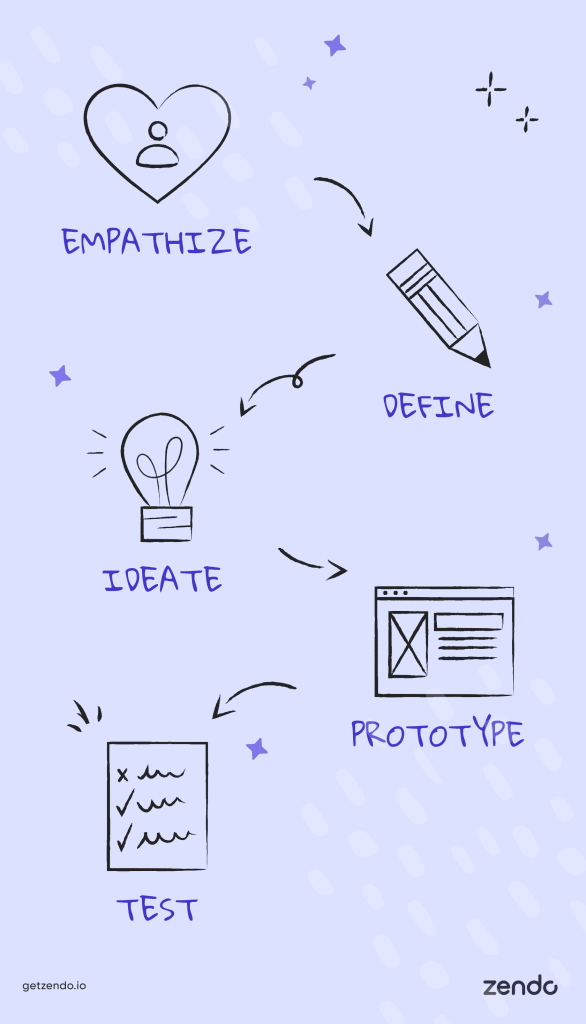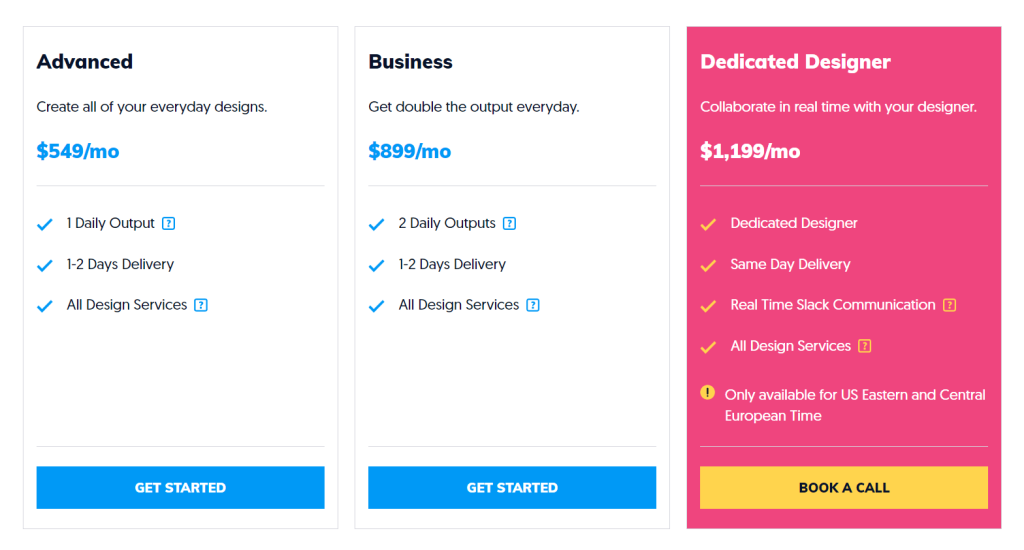Let’s not kid ourselves — graphic designers have it extremely tough.
The market seems to be oversaturated with aspiring designers vying for attention, new technologies that keep disrupting the profession, and amateurs that severely undervalue their work. There are many challenges designers have to face, so if there are easy ways to overcome them — or circumvent them — it feels like a blessing.
And productized services certainly feel like a blessing with the amount of benefits they offer. Most importantly, they can be a real time-saver when used right, allowing you to scale and grow our business without being worried about lost quality of services.
How does it work? Instead of offering vague promises of custom, fully personalized work, you offer straightforward services with strictly defined scope and fixed price alike, resembling physical products. Terms and conditions are fully explained right from the start, clients know what to expect, and you can create processes that bring order to your business.
If you’d like to delve deeper into how to create your own productized services and how they work, read this guide.
For more personalized advice on productization in the graphic design industry, stick to this article and analyze with us the most common challenges designers have to face.
Graphic Design Services: 9 Most Common Challenges
1. Meeting Deadlines
Nothing scares a graphic designer more than a looming deadline. Even though we set them up ourselves, have myriad reminders, and yet procrastination tends to sneak in anyway. This often results in rushed projects done overnight, which couldn’t be possible without a staggering number of energy drinks or coffee. All in all, this lifestyle isn’t the healthiest, more often than not leading to burnout.
But because of how society celebrates the grind culture and “working yourself to death”, along with the more innocent yet still harmful hyperproductivity, many consider this state of affairs a sad yet necessary part of life. All that’s left is to simply accept that and joke around missing deadlines on obscure Reddit channels.

There are many reasons for struggling with meeting deadlines, from burnout and depression to perfectionism and chaotic processes. While some of these reasons might be difficult to tackle, we can surely help you with the last one.
In general, any creative processes are thought to be ruled by imaginary muses, random sparks of inspiration, and many other unspecified factors that romanticize art professions. In reality, graphic design is much more methodological than that.

One of such methodologies is Design Thinking, which consists of 5 steps: empathize, define, ideate, prototype, and test. It’s a universal approach for both bigger and smaller projects, but for yourself, you should try to delve deeper into your creative process and distinguish all the other steps that could ultimately create a powerful todo list. Ideally, it’d be best to have a process per specific project, like logo design, creating marketing materials, social media graphics, and so on.
What benefits can you expect from that approach? Most of all, your work stops feeling so overwhelming. Designing a logo from scratch is a pretty big project; but once you know the exact steps, you feel more in control and the tasks seem easier. In result, the urge to procrastinate, which often stems from uncertainty and fear of failure, lessens, and the deadlines are easier to meet.
If you’re scared that such a rigid process will limit your creativity, we have some good news — constraints actually lead to innovation and force you to start thinking outside the box.
2. Wrong Estimations
Hold up! Don’t graphic designers use methodologies and create their own processes all the time, even for custom work?
They do. The difference is, in the case of productized design services, it’s simply way easier.
In the case of custom projects, there are too many uncertainties at the start and unexpected turns in the middle. And so for example, a new industry could require more research, a client could request more revisions once hit with mindblowing — in their opinion — ideas, or certain requirements could turn out more problematic than first assumed. All in all, a simple project might easily turn out into a giant adventure full of plot twists and many rejected iterations.

Because of that, many projects end up severely undervalued. Not only when it comes to the final price, but also the needed time. It also concerns work on the hourly basis — after all, clients still expect a rough estimation and going way beyond it might require explanations. In result, after hitting a certain point, you might stop billing these hours in order to preserve your good name.
You can say goodbye to all these struggles by productizing your graphic design services. You can calmly estimate the price and delivery time way in advance simply by analyzing your entire process and all its tiny parts. Even if you get it wrong with your first client, you can adjust and offer better rates with the next one. Because each offer is repetitive and predictable, you can also better judge how many jobs you can handle and what kind of revenue you can expect.
3. Scope Creeps
Talking about money is extremely awkward for many people. And no wonder — the rates can make or break a deal. If you charge too high, a potential client might leave for another graphic designer; but if you charge too low, you’re setting yourself up for exploitation. And certain customers might be counting on that.

Even if you stick to appropriate rates, the exploitation part can sneak in anyway, later on. It might be subtle at first — a small revision here, another there. Can you make an additional sign, so that we can switch between the two? And while we’re at it, can you throw in another illustration? You’ve made the previous three so fast, after all, another one won’t make much of a difference.
And even though you might not feel alright with that, the fight over clients is so fierce you won’t risk losing one. Especially when one happy client can lead to many more through recommendations, so you grit your teeth and get to work, hoping that next time you’ll be more assertive.
Sometimes, such situations happen not because people are evil, but because they really don’t know any better. More often than not, customers don’t really understand your work and how much effort it takes. Hence, this might lead to unrealistic expectations and treating you as a personal graphic designer at beck-and-call.
How to protect yourself from that, without coming across as rigid and unyielding? Your best bet is to present clear terms and conditions upfront. When you specify the end results people can expect from you, don’t forget to include the number of revisions, so that you won’t be stuck in an endless loop of feedback. You can also enrich your offer by offering addons — additional services you can add on top of your original service, also known as upselling. This way, when someone asks you about any additions, you can smoothly point them towards your landing page with pricing.
4. Customer Acquisition
There’s also another big benefit to being upfront about your services — it makes customer acquisition easier.
With how oversaturated the current market is, clients can take their sweet time comparing and considering many different options. In the case of graphic design, they can employ any freelancer from such marketplaces as Fiverr or Upwork, scroll through portfolios on Behance or Dribble, or look up their own network on LinkedIn for any hidden gems. They can also simply ask around or post about their search on social media.
That’s why standing out from the crowd is a difficult, daunting art. You have to ensure you’re not lost amid the noise, catch other people’s attention, and convince them that you’re the right person for the job with proper inbound marketing strategy.
Making sure that your online presence, be it a robust profile on social media or your own WordPress website, is memorable and captivating, is crucial. And it doesn’t concern only the visuals — text matters just as much, if not more.
You have to be careful there, though. Many people are wary of general, vague promises that could be applied to just about every business. Instead, you should stick to concrete facts supported by true reviews and testimonials.
The same could be said about pricing. Way too many professionals avoid sharing their rates, preferring to do that privately. And if that’s preceded by many different questions about the scope, the client might change their mind and back out.
This approach only lengthens the sales process, which already takes way too long. But you can shorten it.
By packing your graphic design service into a clear-cut productized service and explaining the terms of collaboration and what can be expected from you, clients have an easier time coming to a decision. They can figure out whether you’re what they’re looking for and appreciate the level of transparency. This can give you an advantage over those who require jumping through hoops in order to get any sort of information.
5. Starting Over
Each new custom project might feel like starting over completely from scratch. You have to go back to the drawing board, having no idea how this project will turn out or which direction the client will finally take. And there’s always the threat of sudden pivot or customers dropping altogether in the middle of the collaboration.
This uncertainty might be exciting for some, but disheartening to others. Thankfully, there’s a way to make the whole process predictable enough to make us feel more sure of ourselves and what the future holds.
Such predictability and repetitiveness can be found in productized design services. Because we’ve designed a pretty sweet workflow for ourselves, we are aware of the common patterns and are able to use them to our advantage. We can improve it even more by preparing in advance all sorts of resources that can be reused with each new client and new case, so that we never have to start over. Instead, we’ll have proven fundamentals on which we can build our project.
Some of these ready-made resources could be:
Questionnaires & Order Forms. First of all, you need to gather some information or offer a space for clients to order the service. In the case of custom projects, you’d simply leave your email or any other form of contact and wait for potential clients to strike up a conversation; with productized services, you can cut down on the communication. You can ask upfront about anything you need to deliver the order and even create a checkout, so that you can get paid instantly.
Automatic messages. Clients really appreciate quick answers. Not only can they strike the deal quickly, but also judge the vendor on their communication skills. But writing emails can take a long while, right? Not if you prepare a bunch of templates in advance, where only some of the fields are to be filled out by you manually. And if you really want to achieve a lightning speed, you can go one step further and automate them with appropriate software.
Mockups. Delivering services not only on time, but also in a beautiful form, could elevate the customer experience and result in 5-star reviews. Usually though, when we’re struggling with meeting deadlines, doing anything extra seems like a waste of time. But now that we’ve made our job repeatable, we can also create many different mockups as templates and reuse them every single time. It’s a perfect way to uplift, let’s say, your ebook cover design, if you send detailed mockups besides the main file.
6. Collecting Payments
And we’re back to money-related problems!
Some clients can be forgetful and in need of frequent reminders. Others might be in money troubles and delay payments from here to eternity. Some might suddenly try to renegotiate the deal, hoping at least for a discount. In all these cases, frustration is unavoidable, sometimes even leading to reconsideration of the chosen profession.
Thankfully, productized services come to the rescue. With this business model, we can collect upfront payments and start our work only after being paid. To make clients feel more safe, you can split the payment into two or promise money back guarantee if anything goes wrong (remember to specifically indicate when the refund applies, in order to protect yourself from scammers).
With the help of proper software, such as Zendo, HoneyBook, or Plutio, you can set up automations to avoid the bothersome work of sending messages. Depending on the software, you can automate reminders, quotes, invoices, and many other things after a specified amount of time.
If you’re working on a subscription basis, offering, for example, monthly plans, where you offer web design services 15 hours a month, collecting your payment regularly can also become a bit of a pain if you do it manually. But once you get a hold of a software meant for productized services, you can set up a recurring payment and enjoy the piece of mind that comes with it.
7. So Many Jobs, So Little Time
No matter what productivity gurus say, there comes a time when we can’t squeeze anything more into our schedule. There’s a limit to how much we can do — and therefore, there’s also a limit to our revenue, unless we keep raising our prices into unimaginable heights.
Otherwise, once we hit that invisible barrier, it’s great to welcome new people on board — a typical evolution from solo entrepreneurship to a small business owner. While it’s a logical next step, it can also be a bit overwhelming; after all, it comes with great responsibility. Not only do you have to take care of someone else’s income, but also ensure that their work meets your standards.
Keeping that standard up in wholly custom projects, especially in a big design team, can be difficult. The answer lies in — you guessed it — productization! By introducing clearly defined processes that are easy to understand and execute, along with previously prepared resources anyone can use, you can expect cohesive results to become the norm.
And then, you can consider bringing more variety into your business, for example marketing services that include written content or productized coaching services, where you can offer 1:1 consultations and audits.
Should YOU Switch to Productized Services Now?
As we have seen, many online businesses could benefit from venturing into a graphic design productized service. But are there any instances when it should be avoided?
If you’re working closely with a few, let’s say, ecommerce businesses that bring you most revenue, then switching entirely into several productized services could scare them off, especially if they’re used to your way of collaborating. Furthermore, if you already have built-in processes that support your custom work and you’re satisfied with your workflow, there’s no point in experimenting.
Note though that if you’re on the fence, you don’t have to drastically change your current model. It’s enough to introduce one or two productized services, see how they do, and how you feel about this new side of your business. Remember that there’s nothing worse than a business going stale and adaptation to the new trends is the key.

A free online training. Delivered daily to your inbox to grow your productized agency.












